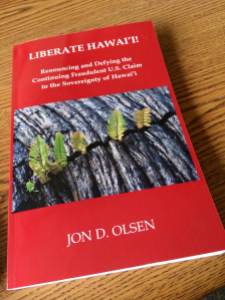Obama Faces Another “Dumb War” Over Crimea by William Boardman
April 11, 2014Dignity vs. Predation: The CCTA Strike by C. W. Norris-Brown
April 11, 2014Liberate Hawai’i
 As 21st century Vermonters continue to explore independence for our once and future republic, it behooves us to remember and dialogue with other independence movements of good will all across the U.S. of Empire. In the middle of the Pacific, the Hawaiian Islands are in the midst of their own independence conversation. Historical snapshot: On August 21, 1959, Hawai’i “joined” (or was kidnapped by) the United States as the 50th state, but only after close to seventy years of annexation and rule by the United States. Jon Olsen’s new book, Liberate Hawai’i, offers a window into the unique historical relationship between Hawai’i and the US. Of Empire, and the book’s subtitle, “Renouncing and Defying the Continuing Fraudulent U.S. Claim to the Sovereignty of Hawai’i” makes clear where the author’s political sympathies lie.
As 21st century Vermonters continue to explore independence for our once and future republic, it behooves us to remember and dialogue with other independence movements of good will all across the U.S. of Empire. In the middle of the Pacific, the Hawaiian Islands are in the midst of their own independence conversation. Historical snapshot: On August 21, 1959, Hawai’i “joined” (or was kidnapped by) the United States as the 50th state, but only after close to seventy years of annexation and rule by the United States. Jon Olsen’s new book, Liberate Hawai’i, offers a window into the unique historical relationship between Hawai’i and the US. Of Empire, and the book’s subtitle, “Renouncing and Defying the Continuing Fraudulent U.S. Claim to the Sovereignty of Hawai’i” makes clear where the author’s political sympathies lie.
The history of the Hawai’ian islands is rich, multifaceted, and well-documented by historians, most notably by Gavin Daws in his well-known work Shoal Of Time. But Daws and others recorded Hawaiian history before the “reveal” of several new documents that shed light on the ongoing relationship between the Islands and the U.S. of Empire. Instead of going big picture, Olsen wisely chooses to focus on the past century of Hawai’ian history, exploring first what he dubs the “1893 Sneak Attack Overthrow,” in which U.S. business and military interests stated a coup d’etat against Queen Liliuokalani, creating a provisional government backed up by military force and then claiming the island as a U.S. “protectorate.” (Sound familiar?) The creation of this “puppet regime,” Olsen writes, “is a shell game wherein the conspirators pretend to be a new government and ask for recognition from the very power that had conspired with them, and without which power they would have been immediately defeated.” (32) Under forcible threat of the execution of her supporters, the beloved Queen Liliuokalani was forced to sign a document “abdicating her throne,” setting in motion a decades-long series of events that destroyed the sovereignty of the Hawai’ian Islands and brought them into U.S. imperial orbit.
“Occupation” and “Resistance” were the watchwords in the decades after the Queen’s surrender. “From 1900 onward for the next half century or more, the people of Hawai’i and especially Native Hawaiians, were treated much like what we call today a ‘third world country,'” Olsen writes. “Hawai’i saw continual encroachment – militarily, economically, politically, and socially. Its resources continued to be plundered, and Hawaiian people were repressed, not often in a brutal manner, like massacres, but severely, as in control of all directions.” (61) And, as Olsen documents, native Hawaiians mounted resistance of all kinds to U.S. imperialism, in an effort to reclaim their sovereignty, a complicated political task, given the diverse melting pot of ethnicities that comprise modern Hawaiian island communities. What would be attractive about independence for 21st century Hawaiian citizens? Removal of the huge U.S. military and economic presence (read IRS, for starters); the return of large land parcels to the natives for cultivation and recreation; a haven for the world’s political refugees, citing traditional Hawai’i’s City of Refuge, within which it was kapu (ITALICS) (taboo) to harm anyone; greater decision-making over Hawai’i’s Commons (land and water rights, in particular), and control over its own diplomatic destiny.
In reading Olsen’s book, I am struck by both the similarities and differences between the sovereignty movements in Hawai’i and Vermont, almost half a world away. Reading Olsen’s vital work is a reminder that our Green Mountain decentralist effort is not alone in our quest for an UNtied States in this new century. Perhaps the future will bring about an unexpected alliance, beginning with more dialogue, between supporters of Hawaiian sovereignty and those advocating a Free Vermont. In the meantime, Olsen’s study provides a window into another important struggle for sovereignty playing out within the U.S. of Empire. Watch the promotional video here.
Liberate Hawai’i by Jon D. Olsen; Goose River Press; 2014; order @ www.gooseriverpress.com
Share this:
- Click to print (Opens in new window)
- Click to email a link to a friend (Opens in new window)
- Click to share on Twitter (Opens in new window)
- Click to share on Facebook (Opens in new window)
- Click to share on Reddit (Opens in new window)
- Click to share on LinkedIn (Opens in new window)
- Click to share on Tumblr (Opens in new window)
